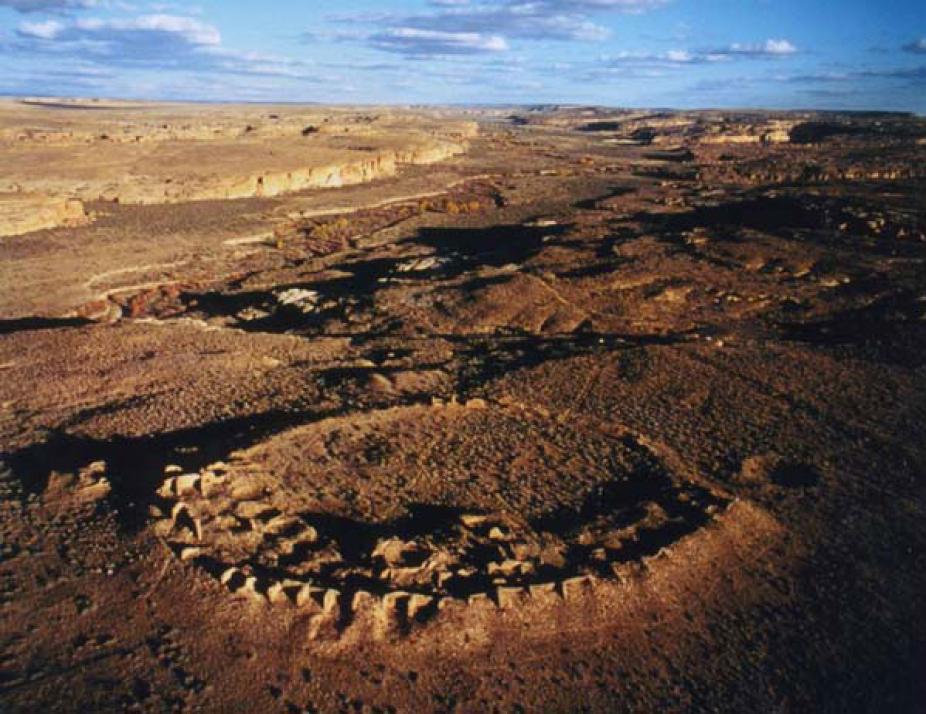Chaco Canyon
By any standards, the climate at Chaco is not ideal for agriculture. Temperatures range between -40 and +40 degrees Celcius, with daily fluctuations often exceeding 35 degrees C. The canyon sees 120 frost-free days on average, but this can vary by ± 30 days from year to year. Rainfall amounts to only 22 cm per year, again with great fluctuations from year to year. Moreover, most of the rainfall is in the form of brief but intense summer thunderstorms. Yearly rainfall is higher in the Northern San Juan basin (about 45cm at Mesa Verde), but the higher elevations lead to colder winters and a shorter growing season.

Aerial view of Chaco Canyon at sunset, looking approximately East. The circular structure in the foreground is the unexcavated ruin of Peñasco Blanco, the westernmost large dwelling in Chaco Canyon.
Copyright, Paul Logsdon
Despite these difficult environmental conditions, in the 1000s and early 1100s Chaco Canyon became the major social, cultural and perhaps ceremonial center of the Anasazi world. By the late eleventh century, at the peak of the so-called Chaco Phenomenon, the canyon numbered 9 large multi-story dwellings (or great houses), numerous smaller buildings, and an estimated total population in the range 2000–5000. Dams and drainage ditches were constructed to divert and retain rain water for farming. An elaborate network of carefully constructed roads radiated from Chaco Canyon to over 70 outlying communities as far as 250 kilometers away in the San Juan basin and beyond. Artifacts found during excavation, such as sea shells and parakeet feathers, indicate that the Chacoan trading network extended as far as the Pacific coast and Mexico. A series of severe droughts in the twelfth century lead to the gradual abandonment of the canyon, which was largely deserted by the mid-1100s. Emigrants from the Mesa Verde area re occupied parts of the canyon in the late 1100s and early 1200s but they, too, eventually moved out of the area. By the beginning of the fourteenth century the canyon was completely deserted.
Why should the ancient Pueblo people have been concerned with astronomy? In addition to the inherent fascination felt by almost anybody looking up to the skies on a clear dark night, there are certainly very practical uses for astronomical observations. Perhaps the most obvious one is time keeping. In particular, for a society that is primarily agricultural and operates in a marginal climatic environment, the establishment of the yearly planting calendar is in fact an activity that is crucial for survival. In addition, based on the practices of modern Pueblo people the scheduling of various religious ceremonies (related or not to planting) is likely to have been an equally important calendrical requirement. Because planting and ceremonies require some time to prepare —both practically and spiritually— it is important to be able to anticipate important planting or ceremonial dates. Keeping track of time through Spring, defined loosely as the time from vernal equinox to summer solstice, is obviously important for agricultural purposes, as different crops have varying growing seasons and so must be sowed at specific times of the year. The winter solstice is also an important ceremonial event, since the Sun must be turned back to ensure the return of Spring. In all likelihood, these dual requirements of agricultural and ceremonial anticipation were at the heart of Anasazi solar astronomical practices.